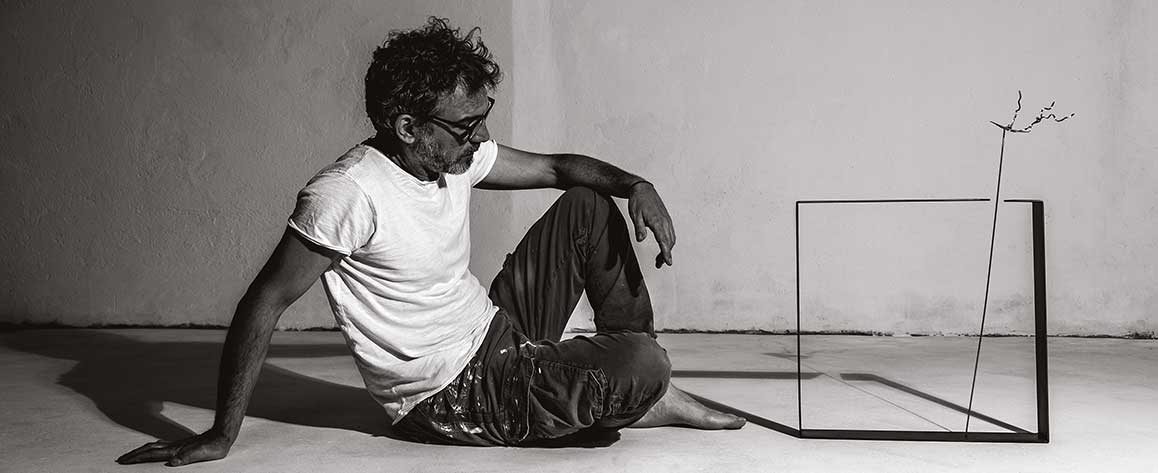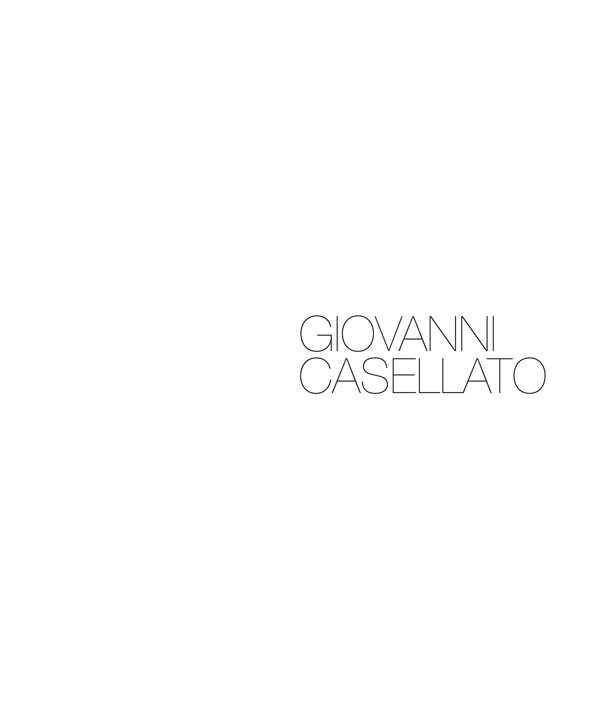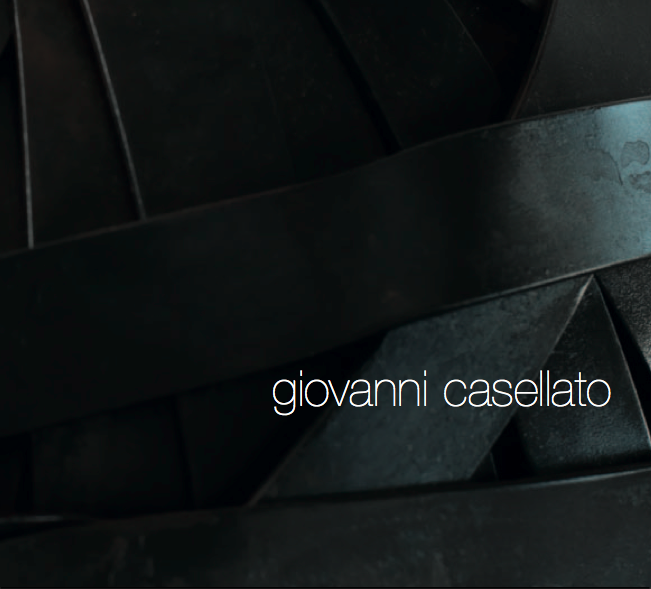about me
Biography
Giovanni Casellato graduated in architecture at the IUAV in Venice. He works as a designer and a sculptor using iron as his main material. He has exhibited in some of the major Italian and European cities, and participated in the Biennale di Venezia in 2008, invited by the Ministry of Environment. Mentioned by Banca Aletti for sculptor as investment art. Giovanni searches within each piece for the fascination and charm of the “piece’s uniqueness”, working meticulously on the shape and on the finish in a way to value its natural aspect, sometimes combining other materials or by using a different oxidation and grinding process.
Giovanni Casellato narrated by Giovanni
I have lived with iron my whole life, my father and grandfather were blacksmiths. I remember the nauseating smell of the liquid used for cooling down the circular saws, and the noise, sometimes deafening, sometimes harmonious, while the iron was being cut in the workshop. I remember the pain when touching the tubes, curls or just forged metal and my father’s warning: “Be careful!”
Iron is a metal I have learned to love by working with it, and something I almost use with defiance, because it is dirty, heavy, difficult to handle and inconvenient to carry. It is a game, the alchemy between knowledge and static, exploiting it and challenging it to obtain illusions. I look for ways to give lightness to very heavy structures such as “Ribbon” which looks soft and light with its curves but weighs as much as a small car, or “Filippo’s Kites” which seem to fly even if made of iron. I exploit the metamorphosis of iron by favouring the oxidation process, exalting the warm tonalities of brown and yellow ochre or grinding, to contrast the natural grey colour of the calamine in the iron thus contributing to eradicate the common look of iron with transparent varnish on natural iron which aesthetically gives it a “cold” finish.
Just after graduation, I was chosen to participate in the Milan Furniture Fair where I displayed several objects which I designed and manufactured in different materials including iron. The Fair gave me the possibility to meet and get to know many great masters like Achille Castiglioni. He urged me to use iron initially as the material for my work because he saw the capacity I had to mould iron in a way which is very different from the traditional method of “wrought iron“, and I … followed his advice.
My first approach to the art world began subsequently, at the same time when I fell in love with iron, and when my children were born, the primary ”muse” inspiration of my work, as in “Filippo’s Kites” and “Laila’s Little Boats”. I was able to let go of the concept of the functional use of iron and to dedicate myself to the pure interpretation of objects and non objects which excites my curiosity and makes me smile: by using different techniques in order to work with one theme or another, with the need to experiment as in ”Tapestry”, “Wool Ball” or “Marinella’s Song”. By almost taking possession of my work technique, I narrate and represent a subject, and afterwards, it becomes obsolete in the approach of the next piece. I see my growth as a journey through my work: I think of the difference between “to Mario Brunello” and “Sufi Dancer”, between “Butterfly” shown at the Venice Biennale and the “Emigrant” tables. I express evolutions or involutions like a reflection of the state of my being in an unconscious way through the art that I have projected and made. I observe my sculptures chronologically and I re-live the emotions felt while growing, I remember the difficulty, the joy, the effort, the dips and peaks of energy at the embryonic stage, the laughter … the curses.
I think how lucky I am to live my work with passion, to physically interpret concepts or ideas that are recognised and endorsed by people who take possession of my work to enhance their spirit or simply to smile by recalling memories.
Giovanni Casellato
The musicality of Giovanni Casellato
Everybody understands something about art: the philologist, the theologian, the critic, the lawyer, the shop assistant, the art historian and the neighbour. We all are ready to talk about art, to discuss it, to evoke myths and legends, and in the end to judge what art really means. Over the years, often I have had the chance to witness various exchanges of views, and to listen to many disagreements, but in the end, one reaches and one reaches still only one conclusion: art is something which goes beyond one’s personal judgment, it is something that exalts the soul of the one who is able to listen to the harmony of it. Because music is art and art could not be without its visual expression. It is this pleasant resonance that reaches the profound that I find in Giovanni Casellato’s work, he is a very refined artist – designer who is able to sacrifice the concept of utility for an art of imaginative life, with its own autonomy from the real, entrusted not to reason but to instinct. His works present perfect smooth surfaces called plates alternating each other with squared levels which seal the shape, sinuous curves that modulate as in “Marinella’s Song”, moulding constantly in different and new ways, like an inexhaustible chain of creation. There is a rhythmic succession of volumes, open and closed, spread and knotted “bonds” always summing up in perfect linearity and in mirroring back, of large and expanded breath. At the same time, Casellato constantly recalls the relationship between the plasticity and the architecture, he conceives in his work the same interpretation for indoor and outdoor spaces. This leap into the immutable dimension of time and space boosts the artist towards the recognition of the sculpture-design with the great traditions of statuary. A concrete example is found in the large left hand on the cello “to Mario Brunello”, an almost totemic figure re-thought and re-launched in the dimension of a triumphant monumentality. We find the same aspect in a previous work “Wool Ball” which is tied to Arianna’s Thread which seems to lead to a freedom of thought that becomes thinner and thinner, accompanied by a muffled sound. Or even “Triptychs”, works of art with a great essence of form, which rise to the infinite and are capable of transmitting the illusion of a three-dimensional form on a two-dimensional surface. Also “Francesca’s Airplanes” as “Filippo’s Kites” and “Laila’s Little Boats” seem to go beyond imagination and whispering with their movement, in the air, in the water, or in nothing, lovely music which is moving away to be imagined, beyond the same boundary of a hypothetical horizon in the unconscious of each spectator. Now is the time to focus on “Sufi Dancer” which appears to be the synthesis of all Casellato’s work. The perfect shape is expressed in the colour of purity, the absolute white, and in the thin, three dimensionality deliberately not expressed. The tiny but perfect harmony of proportion and movement and the rotating dance accompanied by a sweet melody of a ney, with its own sound, sensitive and delicate, represent the divine breath from which all creatures take life. The result of this sensory mix is a sculpture which evokes powerful emotions.
Marika Lion
Art Advisory




